Trains are fascinating. Since their inception during the early 19th century, people have marveled at the technology that makes them go. As they expanded, they forced the creation of standard time so that their trains could be on time. Even today, they remain the largest over-land transporter of goods, loading freight cars with intermodal containers from ships, transporting grain, automobiles, oil, hazardous chemicals, and even garbage. Before the widespread use of the automobile, passenger trains carried people from New York City to San Francisco within a matter of days.
When trains wrecked, they were a site to see. The mangled steel and wood from the train cars intertwined with the track and became national and international news stories. On April 30, 1900, there was one particular train wreck that remains a subject of folk tales, songs, and stories of bravery. On a stretch of track owned by the Illinois Central Railroad, an engineer was attempting to make up for his train’s delayed start leaving the station. A half mile outside of the Vaughan, Mississippi Depot a legend was born when his train crashed. This is the story of Casey Jones.

The Beginning
Jonathan Luther Jones was born in the boot-heel of Missouri on March 14, 1863. As a small child, his family moved to Cayce, Kentucky. When Jones was working for the Mobile & Ohio Railroad in Jackson, Tennessee, he was asked by a fellow boarding house patron where he was from. Jones responded that he was from Cayce. From that moment on he was known as Casey Jones.
Casey Jones was a quick learner and was promoted from laborer to brakeman on the M&O’s Columbus, Kentucky to Jackson, Tennessee route. Soon, Jones was promoted to fireman and worked on the Jackson, Tennessee to Mobile, Alabama route. While Jones was staying at the bordering house in Jackson, he fell in love with the owner’s daughter. Mary Joanna Brady convinced Jones to become a Catholic. He agreed and was baptized in November 1886 and the couple married two weeks later on November 25th.

Casey Jones embraced his role as a husband. With his earnings from the M&O, he and his wife, Janie as she was known, bought a house in Jackson, Tennessee and soon the couple had started a family, eventually having three children. Casey Jones was known as a family man and a teetotaler. Unlike other men on that worked for the railroad, Jones returned to his wife and family each night instead of drinking at the local saloon.
During the summer of 1887, a yellow fever epidemic struck the railroad. Yellow Fever was common during the hot and humid summers in the Mississippi River valley. Individuals who worked for the railroad unwittingly carried the mosquito-born illness with them contributing to its spread. Railroad workers who contracted the disease became very ill and even died. During their convalescence, they could not work. The epidemic opened the door for quick promotions within the railroad hierarchy. On March 1, 1888, Casey Jones went to work for the Illinois Central Railroad as a freight engineer running trains between Jackson, Tennessee and Water Valley, Mississippi.

